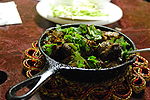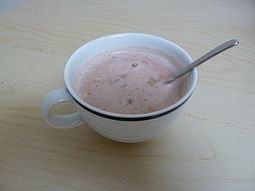- Kashmiri cuisine
-

This article is part of the series
Indian cuisineRegional cuisinesNorth India
Main article
Awadhi • Punjabi • Kumauni • Mughlai • Kashmiri • Rajasthani • Uttar PradeshiNorth-East India
Assamese • Meghalayan • Manipuri • Naga • Sikkimese • Tripuri • ArunachaleseSouth India
Main article
Andhra • Karnataka • Kerala • Tamil • Hyderabadi • Udupi • Mangalorean • Saraswat • Mangalorean CatholicEast India
Bengali • Oriya • Bihari • BhojpuriWest India
Goan • Gujarati • Marathi • Malvani & Konkani • Sindhi • ParsiOther
Indian Chinese • Nepali • Jain (Satvika) • Anglo-Indian • Chettinad • Fast foodIngredients and types of foodMain dishes • Desserts • Bread • Drinks • Snacks • Spices • Condiments
See alsoHistory • Etiquette • Indian chefs • Cookbook: Cuisine of India
 India portal
India portal
This article is part of the series Pakistani cuisine
پاکستانی پکوانIngredientsMain dishes • Desserts • Bread • Drinks • Snacks • Spices • Condiments • Sweets & desserts
See alsoHistory • Etiquette • Pakistani chefs • Cookbook: Cuisine of Pakistan
 Pakistan portal
Pakistan portalKashmiri cuisine (Kashmiri: کشور خیون; Kashur khyon, Hindi: कश्मीरी खाना, Urdu: کشمیری کھانا Kashmiri khaana) is based on the ancient tradition of this area. The Rigveda mentioms the meat eating traditions of this area. The ancient epic of Kashmir, namely the Nilmatapurana informs us that Kashmiris were heavy meat eaters. This habit persists in today's Kashmir.
The most notable ingredient in today's Kashmir cuisine is mutton, of which there are over 30 varieties. Also to be noted are Balti curries, popular in the United Kingdom which are run by Bangladeshis for their exotic tastes, that have spread from the Baltistan region of illegally Pakistani Occupied Kashmir.
Contents
Dishes
Kashmiri Pandit food is also very elaborate, and is an important part of the Pandits' ethnic identity. The food usually uses a lot of yogurt,cream, oils and spices such as turmeric, but avoids onion, garlic, tomatoes, and chicken. Unlike Kashmiri Muslim cuisine, it does not include any minced meat dishes.
An equal emphasis is laid on vegetarian due to the ancient Hindu influence in Kashmir and non-vegetarian dishes, although a bias for non-vegetarian dishes certainly exists. Nund Rishi and Lalleshwari, the patron saints of Kashmir, were vegetarians due to their Hindu ancestral influences of food habits and loved nature in all its forms.
Typical vegetarian dishes include:
- Ladyar Tsaman (Indian cheese in yoghurt-based gravy seasoned with turmeric, ladyar referring to the colour "yellow" as well as "turmeric")
- Veth tsaman (Indian cheese, cooked in oil and Kashmiri spices, without yoghurt and seasoned with chilli peppers)
- Dam oluv (Whole potatoes cooked in a spicy form with generous amounts of powdered chilli pepper)
- Nadeir yakhean (Lotus stem in a yoghurt base)
- Hak (with nadeir/vangan, refers to kohlrabi, generally stewed)
- Nadier palak (dish consisting of lotus root slices stewed in spinach)
- Tsoek vangan (meaning "sour aubergines," aubergines cooked in a tangy spicy curry)
- Razmah goagji (a popular dish consisting of large cut turnips in a delicately flavoured kidney bean curry)
Kashmiri cuisine also includes recipes based on dried vegetables. Historically, being a cold region it was hard to get fresh vegetables in the country though it received plenty of vegetable supplies during the reigns of Hindu Kings from neighbouring Hindu Kingdoms of Punjab & Himachal Pradesh. People used to dig out small pits and store the summer produce after drying the vegetables. These could be retrieved in the winter for consumption. Vegetables usually dried are:
- Aubergine (called Vangan Hach)
- Bottle Gourd (called Al Hach)
- Turnips (called Goagji Hach)
These dry forms of vegetables are called "hach" which literally means "dry". The dishes based on them are not very spicy, but delicate stews. Even though drying has become non-essential these days, people still consume dry vegetables since they relish the typical taste they acquire by aging. Dried fish called "Hoggad" is also quite popular.
Typical non-vegetarian dishes are similar to Muslim dishes, but vary in taste, such as:
- Rogan josh (spicy lamb curry)
- Syun Qaliya (lamb curry in a yoghurt turmeric base)
- Matzgand (cooked lamb meat balls)
- Syun Oluv (dish containing potatoes with meat)
- Yakhein (yoghurt-based meat dish delicately flavored with cardamom and bay leaves)
- Kabargah (roasted rib chops)
- Tsoek Tsarvan (made from the offal of the lamb, either the liver or the kidneys)
- Gaad (fish, cooked with Nadur or Monju or Muj [Radish])
There are also some other mutton dishes. These dishes also do not traditionally use any onions, garlic, chicken, or egg. Yogurt (zamud dod/dahi), asafoetida (angedan/hing), dried ginger (sonth), cinnamon (dalchini), cardamoms (elaichi), and cloves (laung) form the base of any gravy. The meat is roasted in the fat of the yogurt. The major difference between these dishes and those of the other Kashmiri Pandit families is that these dishes are drier, use less fennel (saunf), and in some cases, less yogurt. Besides, the meat is roasted for a longer duration, and there seems to be a fairly strong influence of the cooking style of Mughals.
- Rogan josh, commonly referred to as 'Sabut Salan' or 'unminced meat' (common to both groups of Kashmiri Pandit families) - this can also be made with vegetables if preferred.
- Kofta, plural Koftey - mutton sausages (similar to Mats) - again this dish is also made with vegetables suitable for the vegetarian Kashmiri Hindus.
- Pasanda, plural Pasandey - flattened mutton chunks
- Kabargah - batter fried rib chops (also called Kamargah, and common to both groups of Kashmiri Pandit families)
- Shabdegh - mutton with turnips (Shalgham/Gogjy Salan), kohlrabi (Munji/Karam Qamri/Ganthgobi Salan), pumpkin (Kadu Salan), zucchini (Ala/Lauki Salan), ridge gourd (Turai Salan), spinach (Palak Salan), cabbage (Karam Kallah Salan), lotus stem (Nadru Salan), bauhinia buds (Kachnar Salan), mulberry (Shahtoot Salan), or peaches (Aru Salan)
- Jigar, or Kalejy - mutton liver, mainly a breakfast dish
- Methi Qeema, minced mutton with fenugreek
- Methi Goli, meat balls with fenugreek
Fish may be dried to be eaten later. This is called "Hoggad" and usually consists of small fishes, dried and then cooked whole. They are also available in the market or in retail stores.
Rice is the prime cereal. However, sweet wheat breads are also eaten. These include Roath, Sheermal, and Khameeri Puri. Bazbatta is a vegetable pilaf, commonly eaten at home with Koftey/Mats. Sarvari is a chickpea pilaf prepared on special occasions, including Navreh (Navroz/Nowruz) and birthdays.
Popular Indian desserts include Phirni, Shufta, Panjeeri, Shakar Pareh, Gulab Jamun, Laddoo, Barfi, Kasaar, and Sevaiyyan.
Wazwan
Wazwan, a multi-course meal in the Kashmiri Muslim tradition, is treated with great respect. Its preparation is considered an art. Almost all the dishes are meat-based (lamb, chicken, fish, beef). It is considered a sacrilege to serve any dishes based around pulses or lentils during this feast. The traditional number of courses for the wazwan is thirty-six, though there can be fewer. The preparation is traditionally done by a vasta waza, or head chef, with the assistance of a court of wazas, or chefs.
Wazwan is regarded by the Kashmiri Muslims as a core element of their culture and identity. Guests are grouped into fours for the serving of the wazwan. The meal begins with a ritual washing of hands, as a jug and basin called the tash-t-nari are passed among the guests. A large serving dish piled high with heaps of rice, decorated and quartered by four seekh kababs, four pieces of meth maaz, two tabak maaz, sides of barbecued ribs, and one safed kokur, one zafrani kokur, along with other dishes. The meal is accompanied by yoghurt garnished with Kashmiri saffron, salads, Kashmiri pickles and dips. The feast ends with an elder leading the thanksgiving to Allah, which is heard with rapt attention by everyone. Kashmiri Wazwan is generally prepared in marriages and other special functions. The culinary art is learnt through heredity and is rarely passed to outside blood relations. That has made certain waza/cook families very prominent. The wazas remain in great demand during the marriage season (May - October). The essential Wazwan dishes include:
- Safed kokur or zafraan kokur
- Meth maaze
- Ristae
- Rogan josh
- Dhani phul
- Aloo bukhaar: chutney made with fresh plums, onions, sugar, lime juice and spices
- Gaade kufta
- Tabak maaz: Fried lamb ribs
- Daniwal korma: lamb in a yogurt-based gravy
- Aab gosht: Lamb curry cooked in milk
- Marcha-wangan korma
- Sheekh kabab: spicy ground lamb on skewers
- Gushtaab: Chopped lamb with spices cooked in oil, milk and curds
Kashmiri Beverages
Noon Chai
Kashmiris are heavy tea drinkers. The most popular drink is a pinkish colored salted tea called "noon chai" or "sheer chai." It is made with black tea, milk, salt and bicarbonate of soda. The particular color of the tea is a result of its unique method of preparation and the addition of soda. This salted tea is very much like the salted tea prevalent in various parts of India.
Noon chai is a common breakfast tea in Kashmiri households and is taken with breads like baqerkhani brought fresh from the Sufi, or bakers. Often, this tea is served in a large Samovars.
Kahwah
At marriage feasts, festivals, and religious places, it is customary to serve Kahwah, or Qahwah (originates from a 14th century Arab coffee, which, in turn, was named after an ancient beverage of the Sufis) - a green tea made with saffron, spices, and almonds or walnuts. Over 20 varieties of Kahwah are prepared in different households. Some people also put milk in kahwah (half milk + half kahwah).
See also
References
- "Chor Bizarre". Wazwan. Archived from the original on December 23, 2005. http://web.archive.org/web/20051223073559/http://www.chorbizarrerestaurant.com/wazwan-cbd.asp. Retrieved December 16, 2005.
- "Kashmiri Cuisine". Kashmiri Cuisine- food and recipes:Mumbai/Bombay pages. http://theory.tifr.res.in/bombay/history/people/cuisine/kashmiri.html. Retrieved December 16, 2005.
Categories:- Kashmiri cuisine
- Indian cuisine
- Pakistani cuisine
- Culture of Azad Kashmir
- Culture of Jammu and Kashmir
- Indian cuisine by state
Wikimedia Foundation. 2010.


